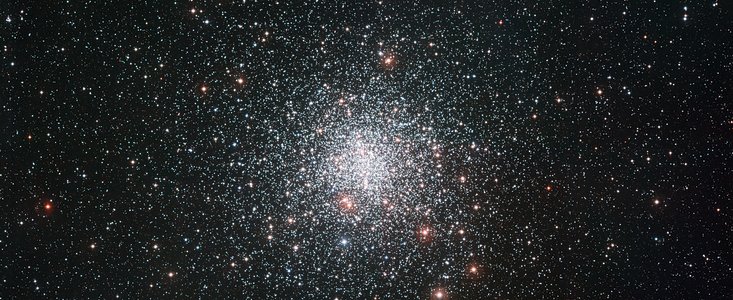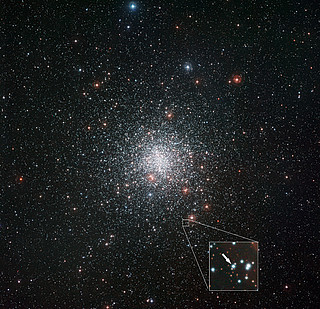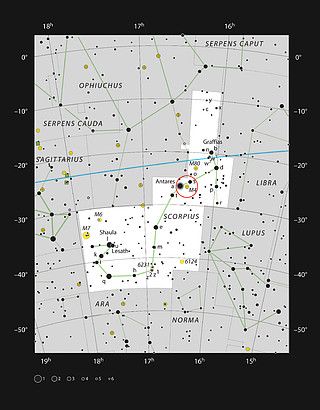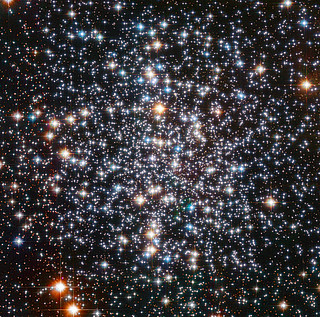

| Visitors Now: | |
| Total Visits: | |
| Total Stories: |

| Story Views | |
| Now: | |
| Last Hour: | |
| Last 24 Hours: | |
| Total: | |
Mysterious Star With The Secret Of Eternal Youth

The Milky Way galaxy is orbited by more than 150 globular star clusters that date back to the distant past of the Universe (eso1141). One of the closest to the Earth is the cluster Messier 4 (also known as NGC 6121) in the constellation of Scorpius (The Scorpion). This bright object can be easily seen in binoculars, close to the bright red star Antares, and a small amateur telescope can show some of its constituent stars.
This new image of the cluster from the Wide Field Imager (WFI) on the MPG/ESO 2.2-metre telescope at ESO’s La Silla Observatory reveals many more of the cluster’s tens of thousands of stars and shows the cluster against the rich background of the Milky Way.
This wide-field view is centred on the globular star cluster Messier 4 (NGC 6121) in the constellation of Scorpius (The Scorpion). It is a colour composite made from exposures from the Digitized Sky Survey 2 (DSS2). The smaller globular cluster at the upper left is NGC 6144. It is similar to Messier 4, but more than three times further away. The red glow of clouds of hydrogen and associated star formation can also be seen in the upper left corner and the bright star Sigma Scorpii can be seen at the upper right.

Credit:ESO/Digitized Sky Survey 2
Acknowledgment: Davide De Martin.
Astronomers have also studied many of the stars in the cluster individually using instruments on ESO’s Very Large Telescope. By splitting the light from the stars up into its component colours they can work out their chemical composition and ages.
This image from the Wide Field Imager attached to the MPG/ESO 2.2-metre telescope at ESO’s La Silla Observatory shows the spectacular globular star cluster Messier 4. This great ball of ancient stars is one of the closest of such stellar systems to the Earth and appears in the constellation of Scorpius (The Scorpion) close to the bright red star Antares.
New observations with ESO’s Very Large Telescope have revealed that one star — marked on this picture — has much more lithium than the other stars in the cluster that have been studied. The source of this lithium is mysterious. Normally this element is gradually destroyed over the billions of years of a star’s life, but this one star amongst thousands seems to have the secret of eternal youth. It has either somehow managed to retain its original lithium, or it has found a way to enrich itself with freshly made lithium.

Credit: ESO
New results for the stars in Messier 4 have been surprising. The stars in globular clusters are old and hence not expected to be rich in the heavier chemical elements [1]. This is what is found, but one of the stars in a recent survey was also found to have much more of the rare light element lithium than expected. The source of this lithium is mysterious. Normally this element is gradually destroyed over the billions of years of a star’s life, but this one star amongst thousands seems to have the secret of eternal youth. It has either somehow managed to retain its original lithium, or it has found a way to enrich itself with freshly made lithium.
This WFI image gives a wide view of the cluster and its rich surroundings. A complementary and more detailed view of just the central region from the orbiting NASA/ESA Hubble Space Telescope was also released this week as part of the Hubble Picture of the Week series.
Notes
[1] Most of the chemical elements heavier than helium are created in stars and dispersed into the interstellar medium at the end of their lives. This enriched material then forms the building blocks of future stellar generations. As a result very old stars, such as those in globular star clusters, which formed before significant enrichment had occurred, are found to have lower abundances of the heavier elements when compared to stars, such as the Sun, that formed later.

Credit: ESO, IAU and Sky & Telescope
This sparkling picture taken by the NASA/ESA Hubble Space Telescope shows the centre of globular cluster Messier 4. The power of Hubble has resolved the cluster into a multitude of glowing orbs, each a colossal nuclear furnace.
Messier 4 is relatively close to us, lying 7200 light-years distant, making it a prime object for study. It contains tens of thousands of stars and is noteworthy in being home to many white dwarfs — the cores of ancient, dying stars whose outer layers have drifted away into space.
In July 2003, Hubble helped make the astounding discovery of a planet called PSR B1620-26 b, 2.5 times the mass of Jupiter, which is located in this cluster. Its age is estimated to be around 13 billion years — almost three times as old as the Solar System. It is also unusual in that it orbits a binary system of a white dwarf and a pulsar (a type of neutron star).
Amateur stargazers may like to track Messier 4 down in the night sky. Use binoculars or a small telescope to scan the skies near the orange-red star Antares in Scorpius. Messier 4 is bright for a globular cluster but it won’t look anything like Hubble’s detailed image: it will appear as a fuzzy ball of light in your eyepiece.

Credit: ESA/Hubble & NASA
Links
A research paper about the surprisingly lithium-rich star in Messier 4 (Monaco et al.)
Photos of the VLT
Photos of the MPG/ESO 2.2-metre Telescope
Other photos taken with the MPG/ESO 2.2-metre Telescope
Photos of La Silla
Contacts and sources:
Richard Hook
ESO, La Silla, Paranal, E-ELT & Survey Telescopes Press Officer
Garching bei München, Germany
2012-09-05 08:51:52
Source: http://nanopatentsandinnovations.blogspot.com/2012/09/mysterious-star-with-secret-of-eternal.html
Source:


